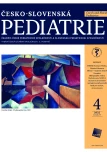DYRK1A-related intellectual disability syndrome
Authors:
Slabá Kateřina 1; Pálová Hana 2; Pokorná Petra 2; Slabý Ondřej 2,3; Konečná Petra 1; Kolbová Lucie 1; Jabandžiev Petr 1,2; Procházková Dagmar 1,4
Authors‘ workplace:
Pediatrická klinika, Fakultní nemocnice Brno a Lékařská fakulta, Masarykova univerzita, Brno
1; CEITEC, Masarykova univerzita, Brno
2; Biologický ústav, Lékařská fakulta, Masarykova univerzita, Brno
3; Ústav lékařské genetiky a genomiky, Fakultní nemocnice Brno a Lékařská fakulta, Masarykova univerzita, Brno
4
Published in:
Čes-slov Pediat 2022; 77 (4): 215-218.
Category:
Case Report
doi:
https://doi.org/10.55095/CSPediatrie2022/035
Overview
DYRK1A-related intellectual disability syndrome is an autosomal dominant disorder characterized by intellectual disability including impaired speech development, autism spectrum disorder, and microcephaly. Affected individuals often have a clinically recognizable phenotype including typical craniofacial dysmorphism, feeding problems, hypertonia, short stature, gait disturbances, and foot anomalies. Other medical concerns relate to febrile seizures in infancy with later development of epilepsy. This case report aims to present a case of a three-year-old girl with DYRK1A syndrome. Since there were no additional diagnostic methods available and the cause of the intellectual disability remained unexplained, we decided to perform whole-exome sequencing (WES). WES led to the identification of heterozygous pathogenic variant p.R205* in DYRK1A gene and enabled us to reach a causal diagnosis in a reasonable time frame. We can conclude, that WES is an efficient diagnostic approach to identify causative genetic variants for syndromes associated with intellectual disability.
Keywords:
Intellectual disability – DYRK1A syndrome – whole-exome sequencing
Sources
1. van Bon BWM, Coe BP, de Vries BBA, Eichler EE. DYRK1A Syndrome. In: Adam MP, Ardinger HH, Pagon RA, et al. (eds.). GeneReviews®. [Internet]. Seattle (WA): University of Washington, Seattle 1993–2021.
2. Earl RK, Turner TN, Mefford HC, et al. Clinical phenotype of ASD-associated DYRK1A haploinsufficiency. Mol Autism 2017; 8 : 54.
3. Arbones ML, Thomazeau A, Nakano-Kobayashi A, et al. DYRK1A and cognition: A lifelong relationship. Pharmacol Ther 2019; 194 : 199–221.
4. Redin C, Gérard B, Lauer J, et al. Efficient strategy for the molecular diagnosis of intellectual disability using targeted high-throughput sequencing. J Med Genet 2014; 51(11): 724–736.
5. Park J, Song WJ, Chung KC. Function and regulation of DYRK1A: towards understanding Down syndrome. Cell Mol Life Sci 2009; 66(20): 3235–3240.
6. Dang T, Duan WY, Yu B, et al. Autism-associated DYRK1A truncation mutants impair neuronal dendritic and spine growth and interfere with postnatal cortical development. Mol Psychiatry 2018; 23(3): 747–758.
7. van Bon BW, Coe BP, Bernier R, et al. Disruptive de novo mutations of DYRK1A lead to a syndromic form of autism and ID. Mol Psychiatry 2016; 21(1): 126–132.
8. Méjécase C, Way CM, Owen N, Moosajee M. Ocular Phenotype Associated with DYRK1A Variants. Genes (Basel) 2021; 12(2): 234.
9. Ernst J, Alabek ML, Eldib A, et al. Ocular findings of albinism in DYRK1A-related intellectual disability syndrome. Ophthalmic Genet 2020; 41(6): 650–655.
10. Meissner LE, Macnamara EF, D’Souza P, et al. DYRK1A pathogenic variants in two patients with syndromic intellectual disability and a review of the literature. Mol Genet Genomic Med 2020; 8(12): e1544.
11. Luco SM, Pohl D, Sell E, et al. Case report of novel DYRK1A mutations in 2 individuals with syndromic intellectual disability and a review of the literature. BMC Med Genet 2016; 17 : 15.
12. Hiraide T, Yamoto K, Masunaga Y, et al. Genetic and phenotypic analysis of 101 patients with developmental delay or intellectual disability using whole - exome sequencing. Clin Genet 2021; 100(1): 40–50.
Labels
Neonatology Paediatrics General practitioner for children and adolescentsArticle was published in
Czech-Slovak Pediatrics

2022 Issue 4
- What Effect Can Be Expected from Limosilactobacillus reuteri in Mucositis and Peri-Implantitis?
- The Importance of Limosilactobacillus reuteri in Administration to Diabetics with Gingivitis
Most read in this issue
- Sepsis in children
- Differential diagnosis of microscopic hematuria
- Hyperthermia, its causes and risks from the pathophysiologist’s perspective
- Dystrophinopathies
